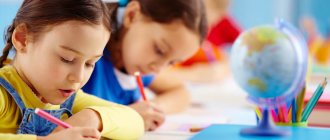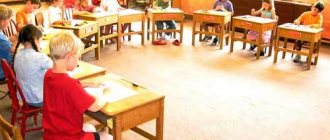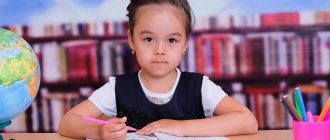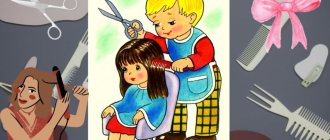Tests for future first-graders
Test 10. Determine the number of vowels and consonants in words. Potatoes, table, pen, game, girl, phone, hand.
Test 11. Retell an excerpt from a fairy tale.
Test 13. Find the extra words. Explain your choice.
Stool, sofa, table, vase, nightstand. Banana, apple, tomato, orange, tangerine. Pencil case, briefcase, notebook, ruler, mug.
Test 14. Determine what fairy tale we are talking about.
Educational games for preschoolers
Game 1 “Find the coin”
The game “Find a Coin” develops memory and attention.
The main essence of the game is to click on the cell and find the coin.
In this game you need to find coins. Houses are drawn on the screen, in these houses you need to find a coin, you cannot click on the same house twice in a row. If you answered correctly, you score points and play further.
Play now
Game 2 "Pathfinder"
The Pathfinder game develops memory.
The main essence of the game is to remember the tracks of animals and repeat them.
In this game, animal tracks appear on the screen, look carefully and remember in what order the tracks appear. Then you need to show which trace appeared first, and which second. If you answered correctly, you score points and play further.
Play now
Game 3 "Diamonds"
The game "Diamonds" develops memory.
The main essence of the game is to remember the order of the figures that light up on the screen and repeat it.
The figures light up on the screen one by one, remember the order in which these figures light up and repeat it. You can do this using the mouse or the cursor on the keyboard. If you answer correctly, you score points and play further.
Play now
Game 4 "Speed Comparison"
The game "Speed Comparison" develops memory and attention.
The main point of the game is to remember the previous item and compare it with the current one on the screen.
An object is displayed on the screen, you remember it and compare it with the next object, if the object is the same, then answer “yes”, if different objects answer “no”. If you answer incorrectly three times, the game ends.
Play now
Game 5 “Complicated high-speed movement”
The game “Complicated high-speed movement” develops memory and attention.
The main point of the game is to remember the previous item and compare it with the current one on the screen.
A picture is displayed on the screen, you remember it and compare it with the next object, if the object is the same, then answer “yes”, if the objects are different, you answer “no”, if the objects are similar, you answer “partially coincides”. This game is designed to increase speed. If you answer incorrectly three times, the game ends.
Play now
Game 6 “Memory Matrix”
The game "Memory Matrices" develops memory and attention.
The main essence of the game is to reproduce the position of the shaded figures.
In each round, a playing field consisting of cells is shown, a certain number of cells are filled in, the rest is left free. You need to remember the location of these cells and repeat their position after they have disappeared on the screen. If you check the boxes correctly, you score points and move on.
Play now
Game 7 "BrainFood"
The BrainFood game develops memory and attention.
The main essence of the game is that in each round a set of elements is shown; you must choose from the set the one that has not yet been selected in previous rounds.
In this game, drinks and food are offered on the screen. You have to choose one thing. In each subsequent round, you must choose a different dish that differs from the previously selected ones. You must remember and always choose different dishes and drinks. If you answer correctly, you gain points and play further.
Play now
Game 8 "Super Memory"
The game “Super Memory” develops memory and attention.
The main essence of the game is that every round a new object appears on the screen; you need to indicate it by clicking on it.
In this game, a round starts and a picture appears on the screen, in the next round another picture appears and the old picture is saved. You only need to click on a new picture. If you answer correctly, you gain points and continue playing.
Play now
Game 9 "Submarines"
The game "Submarines" develops a child's attention.
The main essence of the game is to read the questions and watch the movement of the boat and press the arrows on the keyboard correctly.
Submarines move in the sea in the following directions: left, right, down, up. The question appears on the screen: “Where are the boats pointing?”, “Where are the boats moving?” Look carefully at the question, at the movement of the boats and their direction. Use the arrows to answer the question correctly. For the correct answer you get points and continue playing. If you have three incorrect answers, the game ends.
Play now
Game 10 "Keen Eye"
The game "Sharp Eye" develops attention.
The main point of the game is to remember where the bird, ship and sun are and then indicate where they were.
The screen opens for a few seconds, with a bird, a ship and the sun drawn on it. We need to remember where they are. Then the question is displayed: “Click where the ship was.” You must indicate where the ship was. Then the question is displayed: “Click where the bird was.” You must indicate where the bird was. Then the question is displayed: “Click where the sun was.” You must answer where the sun was and so on. If you answered correctly, you score points and continue playing.
Play now
Development of test tasks for diagnosing the musical abilities of preschool children
Municipal preschool educational institution
general developmental kindergarten No. 9 “Beryozka”
Petrovsk-Zabaikalsky, Transbaikal Territory
Development of diagnostic tasks to determine the levels of musical development of children of early and preschool age.
Prepared by:
Gritsenko Rimma Alexandrovna,
musical director
first qualification category
Petrovsk-Zabaikalsky
2013
Diagnostic tasks for determining the levels of musical development of children of early and preschool age are developed taking into account the requirements of knowledge and skills of the traditional program, intended for preschool educational institutions using the Education and Training Program ed. M.A. Vasilyeva, V.V. Gerbova, T.S. Komarova
Diagnostic tasks in
the 2nd group of early age
| Levels of musical development | Didactic games, exercises, repertoire | Contents of the diagnostic task, questions |
| Perception of musical works | “Lullaby”, “Dance”. MDI "Hares" | Invite children to listen to two different works. Note the mood of each child. Questions: Did you like the music? What kind of music is this - sad or happy? Offer to choose appropriate illustrations: hares sleep, dance. |
| Development of musical memory | Game "Who came to visit?" I Music from the film “Masha and the Bear”, “Good night, kids”. II “Bobik” by T. Popatenko; “Cat” by A. Alexandrov; r.n.p. "Cockerel" | Listening to familiar program works, at the beginning of the year - songs from cartoons. Offer to choose the appropriate toy. Mark active children (they recognize the song, begin to sing along with onomatopoeia, dance) Questions: who is this song about? Who came to visit us? |
| Independent activity when singing along, onomatopoeia | “Ladushki” r.n.p.; “Cat” by A. Alexandrov and etc. Phonograms of children's favorite songs. | Perform songs and chants that children know and love. Mark children who actively sing onomatopoeia: “meow”, “okay”, etc. Invite everyone to sing together. |
| Development of figurative perception | Imitation of the movements of animals and birds. Phonograms "Bunny" "Birds are flying" | Offer to consider bunny and bird toys. Questions: who is this? Offer to depict how a bunny jumps, how birds fly. Then repeat with music. |
| Performing simple musical rhythmic movements | “Here they are” I. Krasev; "The little ones are having fun" Ya. Zhabko | Note the emotionality of the performance all movements as demonstrated by the teacher, independent execution of movements according to the text at the end of the year. |
| Formation of diatonic (sound-pitch) hearing | Game "Who's Singing?" Phonograms “Bear”, “Bird” | Perform musical phrases in lower and upper registers. Offer to choose appropriate toys or pictures. |
| Knowledge of basic musical instruments | Musical instruments: drum, tambourine, rattle. | Offer to look at musical instruments, show the instruments named by the teacher. Task: find a tambourine, etc. Note the children's ability to act with them. |
Diagnostic tasks
in junior group I
| Levels of musical development | Didactic games, exercises, repertoire | Contents of the diagnostic task, questions |
| Perception of musical works | MDI "What are they doing in the house" “March”, “Lullaby”, “Dance”. MDI "Sun and Rain" Fast and slow melodies | Invite children to listen to a variety of works. Note the mood of each child. Questions: Did you like the music? What kind of mood music is this - sad or happy? Offer to choose appropriate illustrations. |
| Development of musical memory | “Herringbone” M. Krasev; r.n.p. “Cockerel”, “Ladushki”; “Cat” by A. Alexandrov. MDI "Guess the cartoon" Music from the film “Masha and the Bear”, “Good night, kids”. | Offer to listen to program works familiar to children and learn songs. Questions: who is this song about? For children who have difficulty, offer songs from cartoons. |
| Independent activity when singing along to musical phrases | Songs from the program material familiar to children and their favorite songs. | Bring in toys. Question: who do you want to sing a song about? Sing a familiar song. Mark actively singing children. If there is any difficulty, offer to sing any song that the child knows. |
| Development of figurative perception | Imitation of animal movements to music. "Bunny", "Bear". | Offer to depict how a bunny jumps, how a bear walks. Repeat with musical accompaniment. Note the emotionality of children’s movements. |
| Formation of skills and abilities of musical and rhythmic movements | Dances familiar to children. “I want to dance”, “Dance with cubes”, “Go dancing” | Note the emotionality of performing movements as shown by the teacher and independently performing movements according to the text. Mark the correctness of the movements: “spring”, “claps”, “stomp with one foot”. |
| Formation of diatonic (sound-pitch) hearing | Musical phrases “Bear”, “Bunny” | Perform the same musical phrases in lower and upper case. Offer to choose appropriate toys. Question: who is coming? |
| Formation of initial ideas about children's musical instruments | Subject pictures: drum, rattle, tambourine, pipe. Musical instruments. | Offer to name the tools yourself based on the pictures. For the correct answer, the child receives this tool. For children who have difficulty, offer to show them the tools named by the teacher. |
Diagnostic tasks
in junior group II
| Levels of musical development | Didactic games, exercises, repertoire | Contents of the diagnostic task, questions |
| Perception of musical works | “March”, “Lullaby”, “Dance”. MDI "What are they doing in the house" MDI "Sun and Rain" | Invite children to listen to different types of works and perform the corresponding movements. Inactive children are encouraged to choose appropriate illustrations. |
| Development of musical memory | “Winter has passed” N. Metlov; “Pies” by A. Filippenko; "Tired toys are sleeping" MDI "Musical Clock" | Invite children to recognize program works and songs from cartoons familiar to children from the introduction and name them. For children who find it difficult, ask them to choose the appropriate pictures. |
| Formation of diatonic (sound-pitch) hearing | "Bird and Chicks" E. Tilicheeva MDI "Guess" Game "High-Low" | Offer to listen to a piece of music. Questions: Does music always sound the same? How do birds chirp? How do chicks chirp? High or low? |
| Formation of dynamic hearing (loud-quiet) | Game "Quiet and Loud" Game "Say Your Name" | Offer to say your name first loudly and then quietly. Offer to listen to a piece of music, determine when it sounds loud and when it sounds quiet. Questions: Does music always sound the same? Listen to the piece of music again. Offer to clap your hands loudly and quietly, according to the sound of the music. |
| Formation of rhythmic hearing | Game "Echo" Ri MR 8/10.14 MDI "Walk" | Clapping simple rhythmic patterns for the teacher. If there is difficulty, do rhythmic games with all the children. Note the clarity of completing tasks at the same pace with everyone else. |
| Development of singing skills | Familiar software works. “Pies” by A. Filippenko, “Winter has passed” by N. Metlov and others. | Sing a song familiar to the children. Invite everyone to sing this song together. Note the performance without tension, the conveyance of the character of the song (fun, affectionately, drawlingly, melodiously), the clear pronunciation of words. If there is difficulty, the child sings any song he knows, without musical accompaniment. |
| Formation of skills and abilities of musical and rhythmic movements | Pair dance “I want to dance” and other dances familiar to children. | Offer to independently start and finish the movement, reacting to the beginning and end of the music. Check the quality of dance movements in familiar dances. Note the rhythmic movement to the music, according to the tempo and nature of the musical piece. |
| Development of dance and gaming creativity | Game “Kittens sleep on the carpet”; Round dance “Who is good with us”, dance melodies | Note active participation in a game situation, in the staging of round dances, independent performance of dance movements to dance melodies. |
| Development of timbre hearing | Musical instruments: pipe, rattle, metallophone, bell, tambourine, drum. MDI: “What does that sound like?” | Ask them to guess which instrument sounds by picking up the corresponding picture. |
| Acquiring skills and abilities to play children's musical instruments and ideas about them | Subject pictures with musical instruments. Noise instruments: rattle, drum, cubes. Dance melody. | Name the musical instruments you know. Name them from the pictures. Play along with the teacher on noise instruments yourself. |
Diagnostic tasks
in the middle group
| Levels of musical development | Didactic games, exercises, repertoire | Contents of the diagnostic task, questions |
| Formation of music listening culture skills | Story game “We are at a concert” | Invite them to imagine themselves as spectators. Remind us of the rules of conduct at a concert. Note the behavior of each child: the ability to listen to a piece to the end without being distracted. Questions: how should we behave at a concert, how should we listen to music correctly? |
| Perception of musical works | MDI "Sun and Rain" | Offer to listen to several pieces of music and correlate the content of the music with the illustration. Note emotional responsiveness to music. Questions: what is the character of the music? |
| Development of musical memory | MDI "Guess who came?" MDI "Guess the cartoon" | Offer to recognize familiar songs from the introduction. For children who find it difficult, ask them to choose the appropriate pictures. |
| Development of dynamic hearing (loud quiet) | Ri Game "Loud and Quiet" | “Rain on the roofs, drip, drip, drip, We clap quietly to the beat, The rain suddenly started getting heavier, Let’s clap louder and faster!” Listening to plays with different dynamics. Question: How does the music sound, loud or quiet? |
| Development of diatonic (sound-pitch) hearing | MDI "Teremok" MDI "Guess" | Offer to look at the illustrations. Question: How does a cow moo? And the calf? What is the voice of a cow? What about the calf? Play musical phrases in lower and upper registers, ask them to select the corresponding pictures. |
| Formation of singing skills and abilities | Performance of familiar songs, program works, songs from cartoons. | If there is difficulty, the child performs a song of his choice, without musical accompaniment. Note: singing with a natural sound, clear intonation, singing with pleasure. |
| Development song creativity | Musical questions "What's your name?" “What do you want, kitty?” | Offer to answer the musical question yourself by composing a melody for the answer. Mark the ability to find the right intonation. |
| Formation of skills of musical and rhythmic movements | Familiar dances and dances. Musical game “The cat walked” | Tag children who actively participate in dancing. Offer to independently change movements in accordance with the two-part form of the music. Mark the correct execution of basic dance movements. |
| Development of rhythmic hearing | Game "Walk" MDI Game "Counting" Rea | Offer to clap the rhythmic pattern together with the teacher, then on your own. If there is difficulty, conduct a rhythmic game with all the children. |
| Timbre development hearing | Game “They brought us toys” MDI | Offer to listen to the sounds behind the screen and guess what instrument sounds. If it is difficult to use subject pictures. |
| Development of dance and gaming creativity | Game "Riding a horse" Round dance “Vanya is walking” Figurative dances “Leaves are spinning”, “Snowflakes” | Celebrate active participation in games, round dances, and figurative dances. Note the ability to independently select movement in accordance with the emotional and figurative content of the music. |
| Formation of music-making skills and knowledge of musical instruments. | Playing along with simple melodies on wooden spoons, drums, metallophones. Game "Grey Little Bunny" Dance melodies. MDI "Musical Instruments" | Note a strong interest in playing music, accurate rendering of a simple rhythmic pattern, and a sense of ensemble. In a didactic game, name familiar musical instruments or mark with a chip those named by the teacher. |
Diagnostic tasks
in the senior group
| Levels of musical development | Didactic games, exercises, repertoire | Contents of the diagnostic task, questions |
| Introduction to musical culture (knowledge of composers, ability to distinguish classical, modern and folk music) | "Flight of the Bumblebee" by Rimsky-Korsakov "Kalinka" r.n.p. Contemporary songs (pop music) Game “Strings, noise, percussion instruments” | a) Offer to name composers familiar to the children; b) Ask who composers are?; c) offer a choice of three works, guess what kind of music they relate to? |
| Knowledge of the main genres of music (march, dance, song) | MDI "What are they doing in the house" “Children's Polka” by M. Glinka, “March” D. Shostakovich, r.n.p. “There was a birch tree in the field” | Invite them to listen to pieces of music and guess what they are doing in the house (select the appropriate illustration) |
| Development of musical memory | Program works, songs from cartoons. | Offer to recognize familiar songs from the introduction. For children who find it difficult, ask them to choose the appropriate pictures. |
| Development of diatonic (sound-pitch) hearing | MDI "Guess" "Steps" Musical ladder | Children use tokens to cover the animals corresponding to the melodies played in different registers. They determine the movement of the melody up, down or on one sound and accordingly moves the toy along the steps of the ladder. |
| Development of timbre hearing (the ability to distinguish by ear the sound of musical instruments and voices) | MDI "Sun and Rain" “What do I play?” “Three Sounds” “Teremok” | Play a melody on an instrument, ask the children to identify the sound of the instrument and cover it with a chip. Play one, two or three different sounds on the piano, the child adjusts the corresponding number of chips. Children listen to music and determine by sound, what character in the fairy tale she comes up. |
| Development of dynamic hearing (ability to use dynamic shades in singing) | "Find the puppy" “We’ll binge loudly and quietly” | Offer to find the hidden toy. The music sounds louder the closer the child is to the toy, and correspondingly quieter the further away. Next, the leader must find the toy hidden by the children, guided by the volume of the song that all the children sing. |
| Formation of singing skills and abilities | Software familiar songs. | Mark singing with a light sound, the ability to take a breath before starting to sing and between musical phrases. For children who have difficulty, ask them to sing any song. |
| Development of solo singing skills | "Musical Echo"; singing familiar songs to negative soundtracks | Note the ability to emotionally convey the content of the song, pure intonation. |
| Development of song creativity | “Guests have come to us”; “Tell a rhyme, sing it” | Mark the ability to stage a song, come up with a melody for a given text. |
| Development of a sense of rhythm | Rhythmic chains “Anechka, Mikhail, Alevtina, Kolya” MDI “Identify by rhythm” | Repeating simple rhythmic patterns after the teacher. The teacher performs the rhythmic pattern of a familiar song by clapping. Children identify the song by rhythm and cover the empty half of the card. |
| Formation of skills in performing dance movements | Dances and round dances familiar to children. | Note the ability to convey the character of music in movement, orientation in space, ability to change movement by musical phrases. |
| Development of dance and gaming creativity | Musical fairy tale "Teremok" | Improvisation of the movements of different characters to music. |
| Formation of skills in playing children's musical instruments | “Andrew the Sparrow”, “Magpie-Magpie”, game “Walk”, “Our Journey” | Offer to perform familiar songs on the instrument individually. Next - in the ensemble. |
Diagnostic tasks
in the preparatory group
| Levels of musical development | Didactic games, exercises, repertoire | Contents of the diagnostic task, questions |
| Communion to musical culture (conscious attitude to the national musical heritage and modern music) | Phonograms from different genres. Game “Classical, modern, folk” Phonogram of the Russian National Anthem. Portraits of composers. | Questions: who writes the music? What is folk music? Classic? Modern? Instrumental? Choir? Vocal? Difference between ensemble and orchestra. Mark your knowledge of musical terms. How is music recorded? Play the Russian Anthem and see if they recognize it from the introduction. |
| Formation of musical taste (presence of favorite works, musical preferences) | Game "Music Store" Musical riddle "Three Bumblebees". Recordings of Rimsky-Korsakov’s “Flight of the Bumblebee” performed by a folk orchestra, a symphony orchestra and a modern arrangement. | Reveal a preference for a piece of music, invite children to speak about it and why they like it (evaluative attitude towards music) |
| Development of musical memory | Game "Guess the melody" Program works. Game "Picture Gallery" | Select appropriate illustrations by famous artists for the cycle of familiar classical works “The Seasons”. |
| Development of vocabulary to determine the nature of a musical work | Two different works. Game "Sun and Rain" | Questions: what feelings does music convey? What is he talking about? How does he tell it? What music? Why does the child relate this work to the picture – rain or sunshine. Mark the ability to justify your choice. |
| Knowledge of basic musical concepts (register, dynamics, tempo) | Game “Musical towers”, “Loud-quiet”, “Fast-slow”. | What is a register? Dynamics? Pace? Duration? Rhythm? |
| Knowledge of complex musical genres (ballet, opera, symphony, concert), classification of musical instruments. | MDI "Strings, percussion, noise". | What kinds of orchestras are there, their composition. What is ballet? Opera? Symphony? Concert? (select the corresponding pictures) |
| Knowledge of composers' works | Portraits of composers. MDI "Children's Album". Game "Name the Composer" | Offer to name composers and their works, identify them by portraits, by works. |
| Development of diatonic (sound-pitch) hearing | Game "Musical ladder" Game "Musical Lotto" | Determine the direction of movement of the melody and show it with the help of a ladder and a toy. Children write circle notes on cards from 1 to 5, from 5 to 1, or 5 on one. |
| Development of a sense of rhythm | Belarusian folk melody “Polly”, “Learn to dance”, MDI “Complete the task” | Tap the beat to the music on a musical instrument (tambourine). Repeat rhythmic pattern. Rendering the rhythmic pattern of a familiar song. Lay out a rhythmic pattern with short and long cards. |
| Development of timbre hearing | MDI "Teremok" MDI “How many of us are singing” MDI “Listen carefully” | Listen to the melody and identify the corresponding character. Offer to listen to a piece of music, determine which instruments perform this piece. |
| Development of dynamic hearing (piano, forte) | "Play with us" | “Big and strong Misha is a bear, He can sing very loudly And the mosquito squeaks quietly, Try it and come up with it yourself.” Offer to come up with the association “Loud-quiet” yourself and voice it. |
| Formation of singing skills | Game “Sing with and without music”; Game "Echo" | Note the expressive performance of a familiar song, ease of performance, clear diction, accurate rendering of the melody, with dynamic and tempo nuances. |
| Development of solo expressive singing skills | Game "Bar Karaoke" | The same diagnostic tasks, but the children sing solo. |
| Development of song creativity | MDI "What are they doing in the house? MDI “Fun and Sad” Game “We are composers” | Offer to improvise a simple melody to a given text, give your musical answer to a musical question. Come up with a melody for a given genre (lullaby, march, dance) for a certain character (sad, joyful, etc.) |
| Formation of skills in performing dance movements. Classification of various dance genres (polka, waltz, round dance, rock and roll, hip-hop) | Game "Disco" "Transformation." | Note the ability to move in accordance with the varied nature of the music. Suggest moving in accordance with musical images: leaves, wind, etc. |
| Development of dance and gaming creativity | "Turnip in a new way" | Improvise the actions of fairy tale characters to the music. Note creative manifestations in staging. |
| Formation of skills in playing children's musical instruments, elementary music playing in everyday life. | Game "Our Orchestra" creative game “Music is everywhere!” | Testing the skills of playing different instruments (lightly hitting a hammer on a metallophone, xylophone), acting with a restrained movement as a mediator (plucking a harp), using the breath correctly when playing wind instruments (pipe, flute), different ways of producing sound on a tambourine, etc. Skill play smoothly in an orchestra, ensemble (teacher-accompaniment, child - solo). Celebrate the ability to create music out of nothing (accompaniment from improvised means) |
Used Books:
- “Program of education and training in kindergarten” / Ed. M.A. Vasilyeva, V.V. Gerbova, T.S. Komarova. – M.: Mosaika-Sintez, 2007.
- “Ladushki” (Holiday every day): A program for musical education of preschool children. Compiled by I.M. Kaplunova, I.A. Novoskoltseva. St. Petersburg: Composer, 2000
- Let's play and sing: Musical games, dances and dramatizations for preschool children. Compiled by N. Metlov, L. Mikhailova. M.: Soviet composer, 1978
- Musical and didactic games for preschoolers. Author-compiler N.T. Kononova. M.: Education, 1982
- “Games, songs and dances for children's parties”, E.V. Gorbina, M.A. Mikhailova, Yaroslavl, Publishing House Academy of Development, 2008.
- “Nyaselki” (Library of the “Ladushki” program), St. Petersburg: Nevskaya Note, 2010







